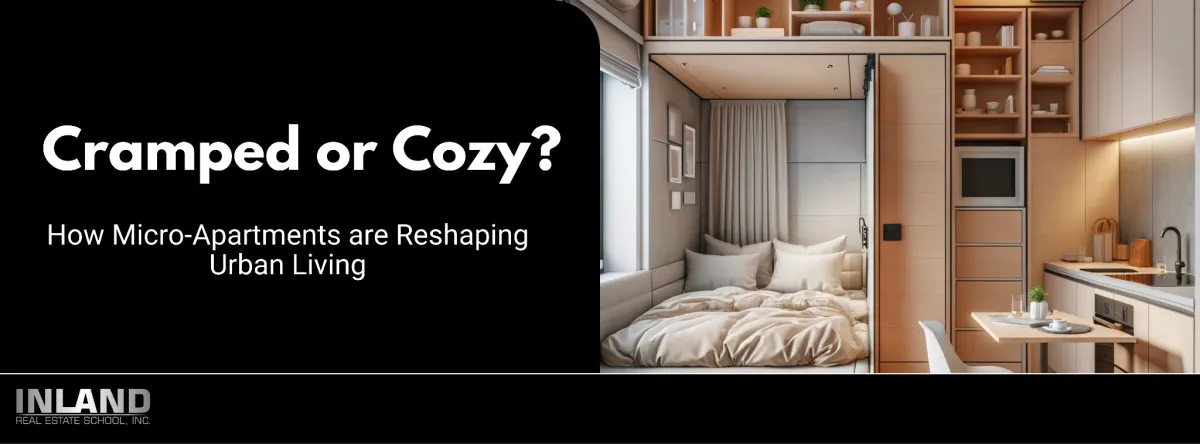
Cramped or Cozy? Micro-Apartments Reshaping Urban Living
Introduction: The rise of micro-apartments
As urban populations swell, a new trend is reshaping the housing market: micro-apartments. Born out of necessity and characterized by their ultra-efficient use of space, these tiny homes are increasingly becoming a fixture in cities around the world, offering a unique blend of affordability, convenience, and minimalist living.
Understanding Micro-Apartments: Size, design, features
Micro-apartments are compact living spaces, typically ranging from 150 to 400 square feet, designed to provide all the essentials of a full-sized apartment in a significantly smaller footprint. They often feature innovative design solutions such as foldaway furniture, lofted beds, and multipurpose spaces to maximize functionality. Despite their small size, these units typically offer full kitchens, bathrooms, and sleeping areas, providing all the essentials for modern living.
The Appeal: Affordability, simplicity, location
Several cities worldwide have embraced the micro-apartment trend. In New York City, the Carmel Place project broke ground as the city's first micro-apartment development, offering units as small as 260 square feet. San Francisco, Seattle, and Boston have also seen an influx of these tiny dwellings. Internationally, cities like Tokyo and Hong Kong are renowned for their compact living spaces, responding to high population densities and limited land availability.
Impact on Real Estate Market: Changing the urban housing landscape
Micro-apartments are having a significant impact on the real estate market, offering an alternative solution to urban housing shortages. In cities with high rental prices, they provide a more affordable option for city dwellers. Moreover, as the demand for urban living continues to grow, micro-apartments help optimize the use of available space, allowing more people to live in city centers. This trend is also sparking innovation in interior design and architecture, as designers seek new ways to maximize utility in minimal spaces.
Criticisms and Challenges: Space constraints, mental health, etc.
However, the micro-apartment trend has not been without criticism. Some argue that the reduced living space can negatively impact mental health, contributing to feelings of claustrophobia and stress. Others note that while micro-apartments are cheaper than larger units, they are often still unaffordable for many city residents. Furthermore, cities' zoning laws and building regulations can pose challenges to the development of micro-apartment buildings.
Future Prospects: The potential of micro-apartments in urban planning
Despite these challenges, the future looks promising for micro-apartments. As cities continue to grapple with population growth and limited housing availability, micro-apartments offer a viable solution to increase housing density without requiring additional land. They also align with emerging lifestyle trends towards minimalist living and environmental sustainability, making them a compelling option for future urban planning strategies.
Conclusion: Redefining urban living spaces
Micro-apartments represent a fascinating shift in urban living, offering a creative solution to the challenges of housing in dense cities. By marrying minimalist design with functionality, they are redefining our understanding of home and challenging the status quo of urban housing. As we look to the future, these tiny dwellings may play a critical role in shaping sustainable, inclusive, and vibrant urban landscapes.
If you found our blog post insightful and you're inspired to dive deeper into the real estate industry, we invite you to explore Inland Real Estate School. With over 25 programs and a proud legacy of serving more than 12,000 students, we are an established, fully licensed Real Estate School in Illinois.
We offer a multitude of learning modes - on-ground classes (live in person or live webinar), home-study, or online (computer-based reading) real estate classes for people who want to get started in the real estate world and want to become real estate brokers, managing brokers, or seek post-license and continuing education throughout the state of Illinois and nationwide online.
Additionally, we have partnerships with schools that provide nationwide education for mortgage brokers and appraisers. We also have affiliations with institutes that can assist you in securing licensing in additional states.
Whether you're a new real estate broker aiming to create your own identity or a seasoned professional looking to upgrade your skills, at Inland Real Estate School, we're committed to investing 110% in you.
References
Kamin, B. (2015). 'Micro apartments: Innovative trend or housing affordability savior?', Chicago Tribune. ↩
McDonald, R. (2017). 'Micro units have become a macro trend', Property Week. ↩
Willett, R. (2016). 'Demand for Micro Apartments is Swelling', RENTCafe Blog. ↩
Jacobs, K. (2016). 'Living Small: The Psychology of Tiny Houses', Psychology Today. ↩
Bellafante, G. (2016). 'Tiny Apartments and Punishing Work Hours: The Economic Roots of Hong Kong’s Protests', The New York Times. ↩
Berger, M. (2017). 'Micro units, once novel, are becoming commonplace', Urban Land Magazine. ↩
Chokshi, N. (2015). 'Tiny Apartments and the Future of City Living', The Atlantic. ↩
Chang, T. (2018). 'Are Tiny Apartments Just a Trend?', CityLab. ↩
Glaeser, E., & Gottlieb, J. (2009). 'The wealth of cities: Agglomeration economies and spatial equilibrium in the United States', Journal of Economic Literature. ↩